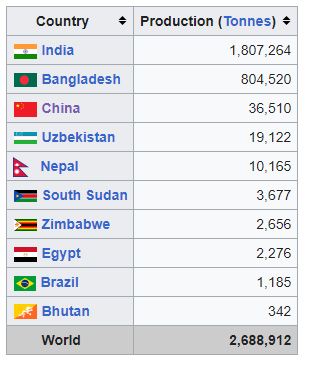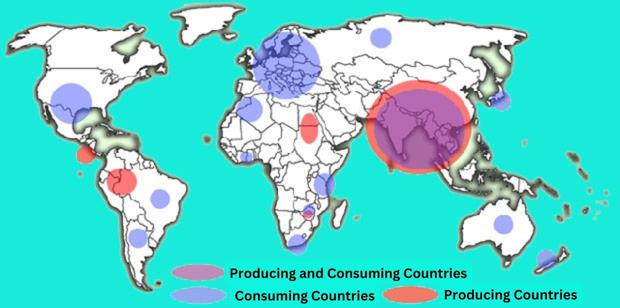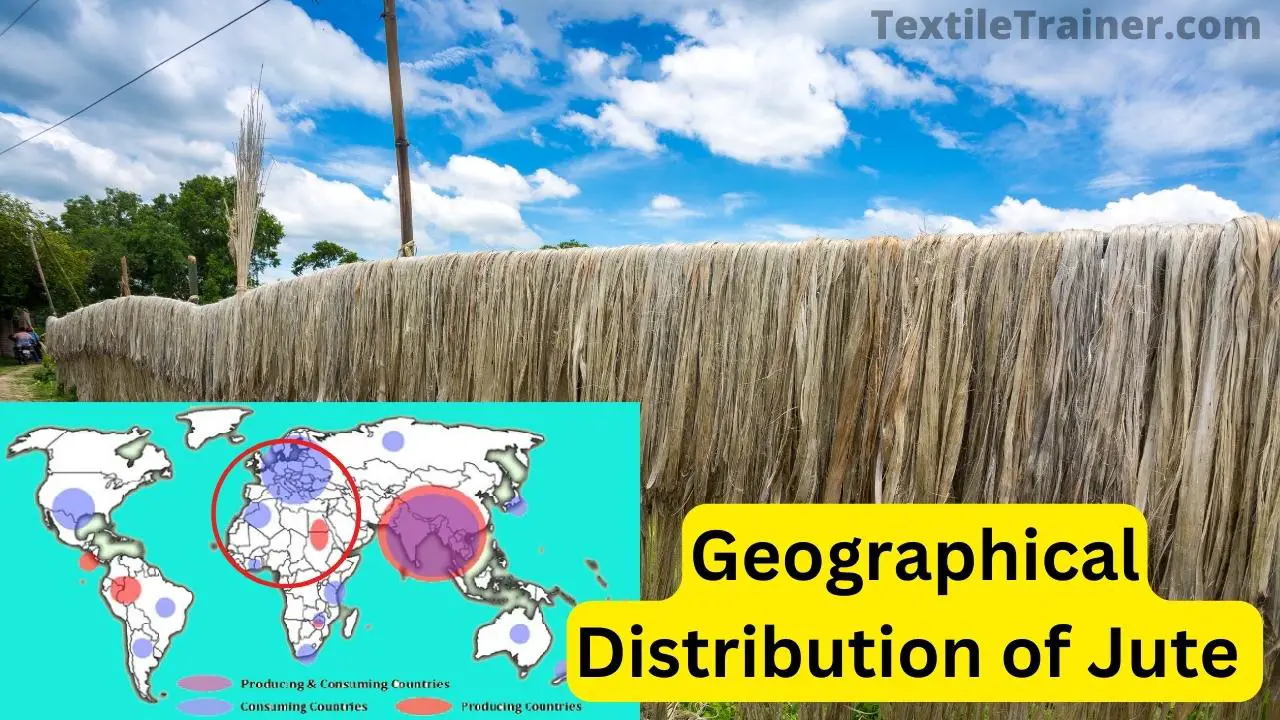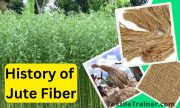Introduction:
Geographical distribution of jute fiber is described easy way in this article. As a versatile and sustainable natural material, jute fiber has a long history and is often referred to as the “golden fiber.” The textile industry derives jute from the Corchorus plant, which thrives in humid and warm climates. Known for its strength, durability, and affordability, jute fiber is primarily used to produce sacks, ropes, carpets, and a host of other eco-friendly products. The main jute-producing countries worldwide have jute fiber, primarily in specific regions of the world. The climatic conditions, fertile soil, and expertise necessary to cultivate jute are ideal for these countries.
Regarding jute production, Bangladesh, India, and China account for a substantial share of the global supply. Bangladesh often hailed as the “jute capital of the world,” boasts extensive jute cultivation across its fertile plains. As a key player in the global jute market, the Ganges-Brahmaputra Delta provides an ideal environment for jute cultivation. Likewise, India has a longstanding association with jute production, particularly in the eastern states of West Bengal, Bihar, and Assam. Besides contributing significantly to global jute fiber production, China has a vast agricultural landscape. However, jute fiber is produced in more than just these countries. The cultivation and harvest of jute are also practiced in other regions, including Thailand, Myanmar, Nepal, and Brazil. As a result of its unique cultivation techniques, each country has its own jute fiber characteristics and qualities. Various stakeholders in the jute industry must understand how jute fiber is distributed geographically. In addition to facilitating efficient raw material procurement, market analysis, and sustainable production practices, it facilitates market analysis. Jute plays a significant economic role in several regions, thus promoting trade and fostering international cooperation.
In order to meet global needs, the geographical area of the main jute producing countries plays a crucial role in meeting the demand for eco-friendly and sustainable materials. Exploring the geographical landscape of jute fiber production provides valuable insights into the industry, its impact on local economies, and its potential for sustainability.
Geographical Distribution of Jute Fiber:
There is something fascinating about the geographical distribution of jute fiber. It shows where this versatile natural material is grown and harvested. Agro-climatic conditions and expertise in jute cultivation distinguish the primary jute-producing countries.
Bangladesh is one of the world’s largest jute fiber producers, often called the “jute capital.” The Ganges and Brahmaputra rivers in Bangladesh form fertile plains and deltaic regions ideal for jute cultivation. In addition to its favorable climate, abundant water resources, and skilled workforce, it holds a dominant position in the global jute market due to its favorable climate and abundant water resources.
Besides Bangladesh, India is also a significant producer of jute fiber. West Bengal, Bihar, and Assam are known for their extensive jute cultivation. These regions have similar agro-climatic conditions to Bangladesh, making them suitable for growing jute. In addition to contributing significantly to the global jute industry, India has a rich history of jute production.
China, with its vast agricultural landscape, is a key player in jute fiber production. With its favorable climate and ideal growing conditions, jute is grown in regions such as Jiangsu, Anhui, and Zhejiang. In addition to meeting domestic demand, Chinese jute production also contributes to the global jute market.
Several other countries, including Thailand, Myanmar, Nepal, and Brazil, have cultivated jute fiber. They possess a suitable climatic conditions and agricultural expertise to cultivate jute fiber. Although their jute production is relatively smaller than the rest of the world’s, they still contribute to the global jute fiber supply.
Numerous stakeholders in the industry benefit from understanding the geographical distribution of jute fiber, as it assists in the strategic sourcing of raw materials, determining market dynamics, and fostering international trade relations. Furthermore, it highlights the economic significance of jute production in specific regions, providing livelihood opportunities for farmers and supporting local economies.
The geographical distribution of jute fiber reflects the diversity and versatility of this natural material. Aside from highlighting the areas where jute flourishes, it also serves as a reminder of this golden fiber’s sustainable potential and importance in a wide range of industries, including textiles, agriculture, and packaging.
By 2020, based on the number of metric tons of jute produced, the following ten countries will be the world’s largest producers.

Jute Consuming Countries:
The eco-friendly and versatile nature of jute fiber makes it ideal for a wide variety of industries. Many countries import jute and consume jute products, whereas some countries are known for their significant jute production.
India is one of the largest producers of jute. It consumes large amounts of jute products, such as bags, sacks, and textiles, which are used for packaging agricultural products and in handicrafts and home furnishings.
In addition to producing jute, Bangladesh also consumes a large amount of jute products. Rice, wheat, and pulses are commonly stored and transported in jute sacks, and rugs, carpets, and various traditional handicrafts are made of jute fibers.
Pakistan, another country in the region, imports jute from other countries to meet its domestic demand. Jute sacks and bags are commonly used in the agricultural sector of Pakistan, especially for wheat, cotton, and rice storage and transportation.
Besides Nepal, Thailand, Myanmar, and Vietnam, other countries that consume jute use it for various purposes, such as packaging, handicrafts, and home textiles. Brazil, Egypt, and Turkey, among others, also consume jute products outside of Asia. For example, the agricultural industry in Brazil heavily uses jute bags, especially for packaging coffee. Egypt uses jute fibers to manufacture ropes, twines, and carpets. In Turkey, rugs and carpets are manufactured with jute fibers.
As a result of its eco-friendly and biodegradable properties, jute products are not only popular in these countries. They have gained popularity across Europe, North America, and Africa as a result of their increased use. Among the products they import are sustainable packaging, home décor, and fashion accessories made from jute. The consumption of jute products is driven by the material’s environmental advantages, aesthetic appeal, and ability to support sustainable and eco-conscious practices. Jute products are expected to become increasingly popular in a wide range of industries as environmental sustainability becomes increasingly recognized.

Conclusion:
Both jute fiber production and consumption are widely distributed across the globe, illustrating the jute’s importance to many countries. Due to the favorable agro-climatic conditions and expertise in cultivating this versatile fiber, Bangladesh, India, and China dominate jute production. As well as meeting their domestic needs, these nations contribute significantly to the global jute market. The global interconnectedness and importance of jute fiber are illustrated by its geographical distribution. It demonstrates the widespread recognition and utilization of jute’s valuable properties in diverse regions of jute cultivation, production, and consumption. As a result of its rich history, versatility, and sustainability, jute continues to make a positive impact on economies, industries, and the environment all over the world.
Reference:
- Belal, P. D. (2009). Understanding Textiles for a Merchandiser . Dhaka: L. B Graphics and Printing.
- Corbman, D. P. (1983). Textiles Fiber to Fabric. NewYork: Mary McGarry.
- Kadolph, S. J. (2006). Textiles. New Delhi: Dorling Kindersley India Pvt. Ltd.
- Siddique, D. H. (n.d.). Natutal Fibers. Dhaka: Hafiz Book Center.
- https://asiajute. com/







1 thought on “Mapping the Geographical Distribution of Jute Fiber in Easy Way”